Zhuoran Zhang
MME-VideoOCR: Evaluating OCR-Based Capabilities of Multimodal LLMs in Video Scenarios
May 27, 2025Abstract:Multimodal Large Language Models (MLLMs) have achieved considerable accuracy in Optical Character Recognition (OCR) from static images. However, their efficacy in video OCR is significantly diminished due to factors such as motion blur, temporal variations, and visual effects inherent in video content. To provide clearer guidance for training practical MLLMs, we introduce the MME-VideoOCR benchmark, which encompasses a comprehensive range of video OCR application scenarios. MME-VideoOCR features 10 task categories comprising 25 individual tasks and spans 44 diverse scenarios. These tasks extend beyond text recognition to incorporate deeper comprehension and reasoning of textual content within videos. The benchmark consists of 1,464 videos with varying resolutions, aspect ratios, and durations, along with 2,000 meticulously curated, manually annotated question-answer pairs. We evaluate 18 state-of-the-art MLLMs on MME-VideoOCR, revealing that even the best-performing model (Gemini-2.5 Pro) achieves an accuracy of only 73.7%. Fine-grained analysis indicates that while existing MLLMs demonstrate strong performance on tasks where relevant texts are contained within a single or few frames, they exhibit limited capability in effectively handling tasks that demand holistic video comprehension. These limitations are especially evident in scenarios that require spatio-temporal reasoning, cross-frame information integration, or resistance to language prior bias. Our findings also highlight the importance of high-resolution visual input and sufficient temporal coverage for reliable OCR in dynamic video scenarios.
EAP-GP: Mitigating Saturation Effect in Gradient-based Automated Circuit Identification
Feb 07, 2025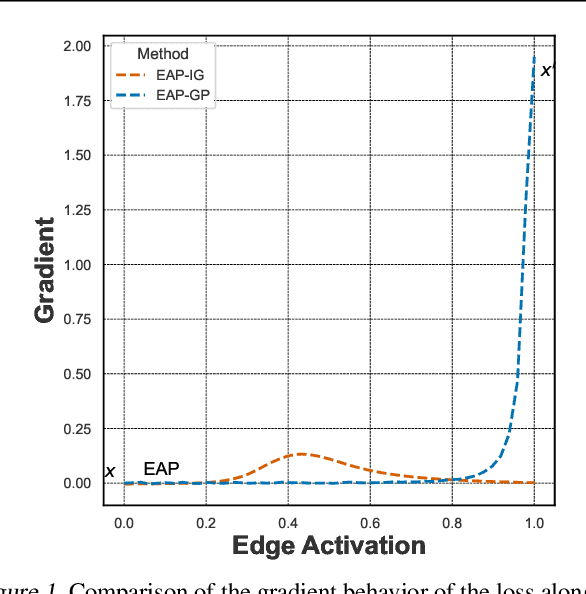

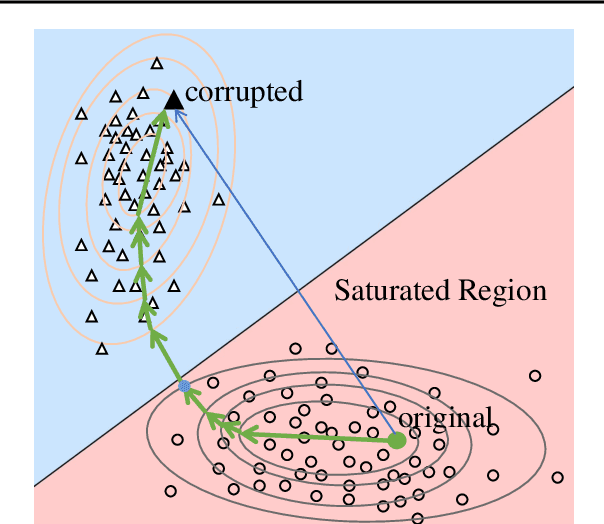

Abstract:Understanding the internal mechanisms of transformer-based language models remains challenging. Mechanistic interpretability based on circuit discovery aims to reverse engineer neural networks by analyzing their internal processes at the level of computational subgraphs. In this paper, we revisit existing gradient-based circuit identification methods and find that their performance is either affected by the zero-gradient problem or saturation effects, where edge attribution scores become insensitive to input changes, resulting in noisy and unreliable attribution evaluations for circuit components. To address the saturation effect, we propose Edge Attribution Patching with GradPath (EAP-GP), EAP-GP introduces an integration path, starting from the input and adaptively following the direction of the difference between the gradients of corrupted and clean inputs to avoid the saturated region. This approach enhances attribution reliability and improves the faithfulness of circuit identification. We evaluate EAP-GP on 6 datasets using GPT-2 Small, GPT-2 Medium, and GPT-2 XL. Experimental results demonstrate that EAP-GP outperforms existing methods in circuit faithfulness, achieving improvements up to 17.7%. Comparisons with manually annotated ground-truth circuits demonstrate that EAP-GP achieves precision and recall comparable to or better than previous approaches, highlighting its effectiveness in identifying accurate circuits.
Pilot-guided Multimodal Semantic Communication for Audio-Visual Event Localization
Dec 09, 2024Abstract:Multimodal semantic communication, which integrates various data modalities such as text, images, and audio, significantly enhances communication efficiency and reliability. It has broad application prospects in fields such as artificial intelligence, autonomous driving, and smart homes. However, current research primarily relies on analog channels and assumes constant channel states (perfect CSI), which is inadequate for addressing dynamic physical channels and noise in real-world scenarios. Existing methods often focus on single modality tasks and fail to handle multimodal stream data, such as video and audio, and their corresponding tasks. Furthermore, current semantic encoding and decoding modules mainly transmit single modality features, neglecting the need for multimodal semantic enhancement and recognition tasks. To address these challenges, this paper proposes a pilot-guided framework for multimodal semantic communication specifically tailored for audio-visual event localization tasks. This framework utilizes digital pilot codes and channel modules to guide the state of analog channels in real-wold scenarios and designs Euler-based multimodal semantic encoding and decoding that consider time-frequency characteristics based on dynamic channel state. This approach effectively handles multimodal stream source data, especially for audio-visual event localization tasks. Extensive numerical experiments demonstrate the robustness of the proposed framework in channel changes and its support for various communication scenarios. The experimental results show that the framework outperforms existing benchmark methods in terms of Signal-to-Noise Ratio (SNR), highlighting its advantage in semantic communication quality.
Data Driven Automatic Electrical Machine Preliminary Design with Artificial Intelligence Expert Guidance
Nov 18, 2024



Abstract:This paper presents a data-driven electrical machine design (EMD) framework using wound-rotor synchronous generator (WRSG) as a design example. Unlike traditional preliminary EMD processes that heavily rely on expertise, this framework leverages an artificial-intelligence based expert database, to provide preliminary designs directly from user specifications. Initial data is generated using 2D finite element (FE) machine models by sweeping fundamental design variables including machine length and diameter, enabling scalable machine geometry with machine performance for each design is recorded. This data trains a Metamodel of Optimal Prognosis (MOP)-based surrogate model, which maps design variables to key performance indicators (KPIs). Once trained, guided by metaheuristic algorithms, the surrogate model can generate thousands of geometric scalable designs, covering a wide power range, forming an AI expert database to guide future preliminary design. The framework is validated with a 30kVA WRSG design case. A prebuilt WRSG database, covering power from 10 to 60kVA, is validated by FE simulation. Design No.1138 is selected from database and compared with conventional design. Results show No.1138 achieves a higher power density of 2.21 kVA/kg in just 5 seconds, compared to 2.02 kVA/kg obtained using traditional method, which take several days. The developed AI expert database also serves as a high-quality data source for further developing AI models for automatic electrical machine design.
Locate-then-edit for Multi-hop Factual Recall under Knowledge Editing
Oct 08, 2024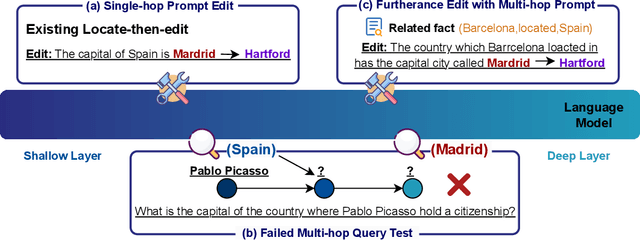
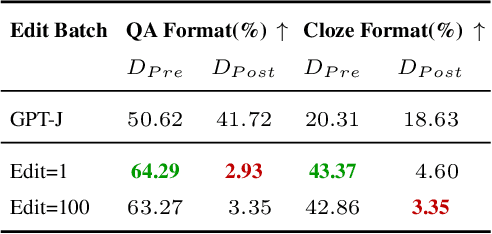

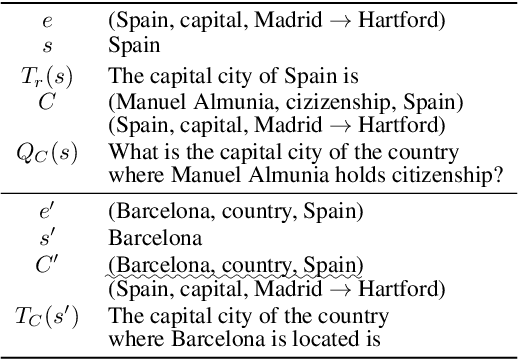
Abstract:The locate-then-edit paradigm has shown significant promise for knowledge editing (KE) in Large Language Models (LLMs). While previous methods perform well on single-hop fact recall tasks, they consistently struggle with multi-hop factual recall tasks involving newly edited knowledge. In this paper, leveraging tools in mechanistic interpretability, we first identify that in multi-hop tasks, LLMs tend to retrieve implicit subject knowledge from deeper MLP layers, unlike single-hop tasks, which rely on earlier layers. This distinction explains the poor performance of current methods in multi-hop queries, as they primarily focus on editing shallow layers, leaving deeper layers unchanged. To address this, we propose IFMET, a novel locate-then-edit KE approach designed to edit both shallow and deep MLP layers. IFMET employs multi-hop editing prompts and supplementary sets to locate and modify knowledge across different reasoning stages. Experimental results demonstrate that IFMET significantly improves performance on multi-hop factual recall tasks, effectively overcoming the limitations of previous locate-then-edit methods.
Automated Sperm Morphology Analysis Based on Instance-Aware Part Segmentation
Jul 31, 2024Abstract:Traditional sperm morphology analysis is based on tedious manual annotation. Automated morphology analysis of a high number of sperm requires accurate segmentation of each sperm part and quantitative morphology evaluation. State-of-the-art instance-aware part segmentation networks follow a "detect-then-segment" paradigm. However, due to sperm's slim shape, their segmentation suffers from large context loss and feature distortion due to bounding box cropping and resizing during ROI Align. Moreover, morphology measurement of sperm tail is demanding because of the long and curved shape and its uneven width. This paper presents automated techniques to measure sperm morphology parameters automatically and quantitatively. A novel attention-based instance-aware part segmentation network is designed to reconstruct lost contexts outside bounding boxes and to fix distorted features, by refining preliminary segmented masks through merging features extracted by feature pyramid network. An automated centerline-based tail morphology measurement method is also proposed, in which an outlier filtering method and endpoint detection algorithm are designed to accurately reconstruct tail endpoints. Experimental results demonstrate that the proposed network outperformed the state-of-the-art top-down RP-R-CNN by 9.2% [AP]_vol^p, and the proposed automated tail morphology measurement method achieved high measurement accuracies of 95.34%,96.39%,91.2% for length, width and curvature, respectively.
 Add to Chrome
Add to Chrome Add to Firefox
Add to Firefox Add to Edge
Add to Edge